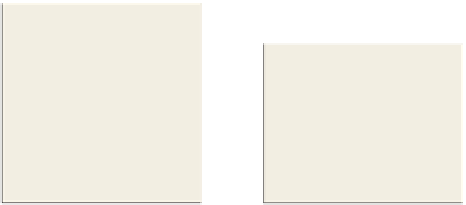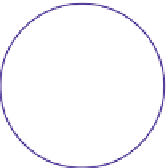Graphics Reference
In-Depth Information
1
2
0.5
1
0
0
2
0.5
2
1
2
1
2
2
2
1
2
0.5
0
0.5
1
2
2
2
1
0
1
2
(a)
(b)
Figure 24.1: Two implicit curves in the plane. (a) The circle is defined by x
2
+
y
2
=
1
,or
by x
2
y
2
x
2
y
2
2
x
2
y
2
+
−
1
=
0
.(b)The
lemniscate of Bernoulli
is defined by
(
+
)
=
2
c
(
−
)
;
changing c adjusts the angle at which the lines cross at the center of the figure eight.
In Chapter 7 we discussed two ways to describe a line in the plane: either para-
metrically (writing
P
+
t
d
, for values
t
R
) or implicitly (in a form like
Ax
+
By
+
C
=
0, with
A
and
B
not both zero; or in vector form,
(
X
∈
n
=
0,
where
n
is a nonzero vector in the plane and
P
is a point of the line—the set of
points
X
satisfying this equation forms a line containing
P
and perpendicular to
n
).
In addition, we observed that it was particularly easy to find the intersection of a
parametric line with an implicit line. Similarly, in 3-space we could define a plane
implicitly, and ray-plane intersections were easiest when the ray was parametric
and the plane implicit.
We further generalized to talk about implicitly defined curves in the plane
that were more general than lines, like the circle, defined by
x
2
+
y
2
=
1, or
more general curves (see Figure 24.1). More generally, if we have any function
z
=
F
(
x
,
y
)
defined on the plane,
1
such as the height of the terrain at each location
(
x
,
y
)
in some hilly area, then the sets of points defined by
F
(
x
,
y
)=
c
are called
contour lines
and are an example of a
level set
of a function (in the sense that
they are the points at the same level on the graph of
F
). Level sets are sometimes
also called
isocurves
of
F
. Mathematics topics often discuss level sets by only
considering the case
c
=
0; that's because the level set where
F
(
x
,
y
)=
c
is the
level set where
G
(
x
,
y
)=
0 if we define the function
G
by
−
P
)
·
G
(
x
,
y
)=
F
(
x
,
y
)
−
c
.
(24.1)
Thus, you'll sometimes encounter the term
zero set
rather than “level set.”
Because the points of the curve are defined indirectly—we simply have the
function
F
which tells us whether a point is on the curve or not—we also say that
the curve is an
implicit curve.
If the formula for
F
is sufficiently complicated, it
may not even be clear whether the set defined by
F
(
x
,
y
)=
c
is empty or not.
1. We are following the mathematics convention that the
xy
-plane is horizontal and that
the
z
-direction is vertical, because the
xy
-plane is of primary interest to us for the time
being; were we to follow the graphics convention, we'd have to describe a circle by an
equation like
x
2
+
z
2
=
1 instead of
x
2
+
y
2
=
1; the familiarity of the
xy
-formulation
seems worth the inconsistency in the choice of axes.























